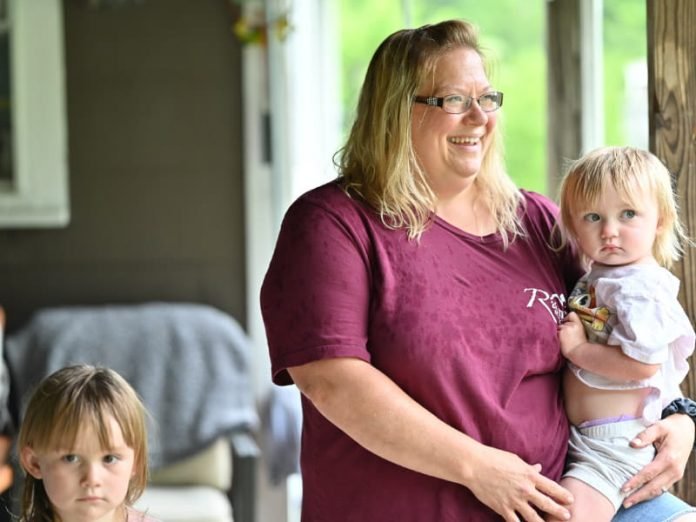
Like many people in rural West Virginia, Sabrina Ford grew up on beans cooked with lard and cornbread loaded with sugar, often with a side of fried potatoes cooked in bacon grease.
This was the food her mother grew up on, and when Ford became a mom, she prepared this meal and other fried foods for her children.
But years of eating high-fat, fried and sugary foods have resulted in another family legacy: heart disease and other chronic illnesses. Of her mother’s 15 siblings, 14 have had open-heart surgery or stents placed to open clogged arteries. Ford’s sister had a heart attack at age 51.
Ford, 52, has Type 2 diabetes, a major risk factor for heart disease and stroke. She had a mini-stroke in January, discovered several of her arteries had blockages and is now on cholesterol-lowering medication.
Her 28-year-old daughter, Sarah Ward, has prediabetes and battles to keep her blood pressure under control. Ford also has a 30-year-old daughter who struggles with irregular heart rhythms.
As the director of nursing at Rainelle Medical Center, the only clinic serving the town’s roughly 1,170 residents, Ford is well-versed in the risk factors contributing to heart disease, diabetes and other illnesses. She worries that if she doesn’t change the unhealthy situation, her grandchildren will be next.
“I don’t want that for them,” she said, nor does she want to miss seeing them grow up. “I want to be around for a long time. I want to see them graduate high school.”
Ford has reason to be concerned.
Rural Americans – particularly those in Appalachia – face some of the highest rates of heart disease and chronic illness in the nation.
West Virginia ranks at or near the top for rates of cardiovascular disease and diabetes, along with cardiovascular risk factors such as high blood pressure, smoking and obesity.
Multiple factors contribute to these health problems.
Traditional diets, cultural differences and social factors beyond people’s control make healthier choices difficult.
West Virginia has high poverty and low educational levels, limited access to nutritious foods and opportunities for physical exercise, and lack of transportation to get to the region’s limited health care facilities.
The end result is that people there don’t live as long as everyone else, and rural residents as a whole are more likely to die from heart disease and stroke.
On average, the life expectancy of rural Americans overall is about 2.5 years less than people living in urban areas, according to research conducted before the COVID-19 pandemic.
In West Virginia, they lose additional time, with a life expectancy of 72.8 years as of 2020, the latest year for which state-level data is available from the Centers for Disease Control and Prevention. That’s compared to 77 that same year for the nation.
Ford and her daughter, Ward, a diabetes specialist at the medical center, are working to break the stranglehold chronic illness has over their town and much of West Virginia through Wellness Works, a center-run program that includes a series of exercise, dietary and other initiatives to encourage creating and maintaining a healthier lifestyle.
They believe the best thing they can do for their family and community is to lead by example.
“Over the last year, I’ve been making some lifestyle changes myself,” Ford said. “I’m dieting, watching what I eat. I’ve lost 60 pounds. I want to pass it down to my grandchildren that we practice good healthy habits.”
Ford and Ward don’t just ask their patients to get up and move. They walk alongside them each Wednesday through the streets of Rainelle and a local park.
Ward and her colleague, Ashley Berry, hold Facebook Live cooking demonstrations, preparing healthy meals they test in their own kitchens and feed to their own families.
Ford grows fresh fruits and vegetables in her backyard garden, teaching her granddaughters to appreciate the taste of freshly picked strawberries and lettuce.
And they leverage a range of federal, state and nonprofit grants and resources to make the most of what they’ve got.
Rainelle Medical Center receives federal funds to provide primary care services to underserved areas. It serves more than 14,000 people in three counties through 11 community health centers, two dental centers, 20 counseling locations, a nephrology center, two pharmacies and seven school-based health centers.
The medical center is among the more than 100 rural federally qualified health centers participating in the American Heart Association and American Medical Association’s Target:
BP program, which provides staff with training, education and the tools they need to help people track and treat high blood pressure.
Also known as hypertension, high blood pressure is a major risk factor for cardiovascular disease and other chronic illnesses. If people cannot get to the health center, workers go to their homes to measure blood pressure levels and manage medications.
Their efforts are starting to make a difference.
Across the region they serve, Ward said they’ve lowered hypertension an average 8.4% and cholesterol by an average 11% since launching Target: BP in 2017.
Patients enrolled in a separate diabetes program that includes health education and monitoring also are seeing major improvements.
Blood glucose levels have fallen dramatically, dropping an average 32%, while A1C – a snapshot of how well a person maintains blood glucose over time – has dropped 42% on average, from 13% to 7.5%. An A1C below 5.7% is normal.
This is no small feat in a town with just one gym and one single grocery store providing limited healthy food choices for a population with a high poverty rate.
Berry, a 36-year-old nurse who had gestational diabetes during both of her pregnancies, knows just how hard it can be to make lifestyle changes. Just three years ago, she was 80 pounds heavier, eating poorly and not exercising.
“I was in the worst shape of my life,” she said. When she was tasked with helping to run the Wellness Works program, “it kind of amped up my motivation.”
“I started really watching what I ate,” said Berry, who grew up drinking a lot of sweet tea and snacking on cookies and chips.
She stopped buying sweetened drinks for her family and focused on reducing saturated fats and increasing fiber. Getting started was difficult, she said, until she got into a routine.
“I started looking at the food as a whole and what benefits it has. I don’t really count carbs or calories or anything anymore,” she said.
“It’s more of a lifestyle change. If I want spaghetti and meatballs, I have it, but it might be a turkey meatball or spaghetti squash. Instead of bread, I have a salad. I make vegetables with every meal.”
Berry is responsible for maintaining the medical center’s Facebook page, where she occasionally includes personal posts to let people see she’s practicing what she preaches. “I want people to have this personal connection with me. Like, ‘If she can do it, maybe I can, too.'”
Ward hopes telling their stories will motivate others.
“We use our influence as health care professionals to display how being active, cooking healthy meals, shopping for better choices at the grocery store and growing you own food can be possible, even with the barriers we all face,” she said.
As Ward and Berry wrapped up a cooking demonstration, showing people how to make bean, avocado and red cabbage salad wraps, Ward’s young daughter, McKenna, waited impatiently outside the door for a sample.
That’s encouraging, said Ward, who hopes the next generation will grow up seeing these types of food as normal. “Because this type of salad is adventurous. For our culture, it is.”
Written by Walter Johnson Jr./American Heart Association.
If you care about heart disease, please read studies that herbal supplements could harm your heart rhythm, and how eating eggs can help reduce heart disease risk.
For more information about heart health, please see recent studies that apple juice could benefit your heart health, and results showing yogurt may help lower the death risks in heart disease.



